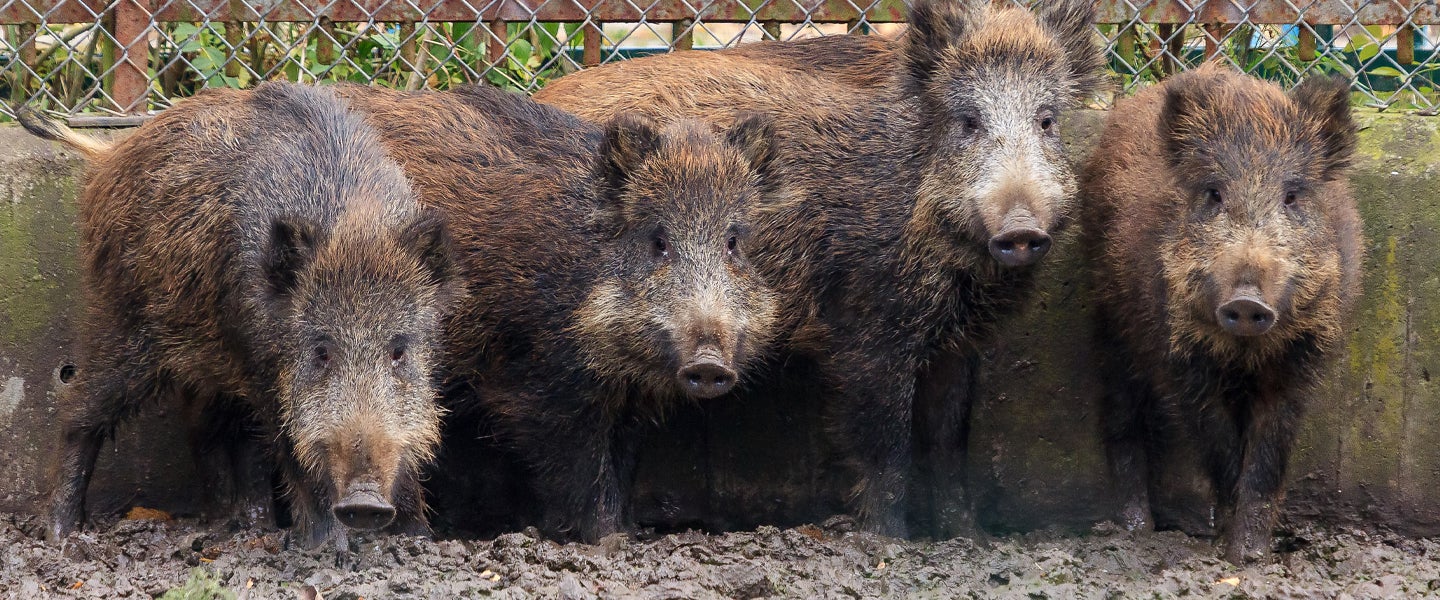From the very start, the hogs were political.
Only a debate as absurd and extreme as the one over guns in America could have led to the tweet that put hogs in the spotlight. It was August 4, 2019, when a young man opened fire outside a bar in Dayton, Ohio, killing nine people. All of 13 hours before, a gunman had murdered 22 people at a Walmart in El Paso, Texas — still the deadliest U.S. mass shooting of the year. The country, although somewhat inured to such violence, was nonetheless shaken by the speed and scale of these attacks. The cries for gun control and bans on assault weapons were louder than usual (the Dayton shooter had used an AR-15-style pistol and wrought horrific carnage within just 32 seconds). The Second Amendment folks pushed back.
Which is how we came to this curious exchange between Alabama singer-songwriter Jason Isbell and Willie McNabb, a father in rural Arkansas who has something of a hog dilemma.
Legit question for rural Americans – How do I kill the 30-50 feral hogs that run into my yard within 3-5 mins while my small kids play?
— Willie McNabb (@WillieMcNabb) August 4, 2019
The scenario is, you have to admit, pretty wild. The specific yet wide-ranging herd estimate of “30-50.” The same beautiful ratio recapitulated in the “3-5 minutes” of action. The chaotic image: spraying bullets at your children as they flee hogs — and not domesticated hogs, feral hogs. Because it had been a grim, terrifying weekend to live through, the McNabb Hog Defense was hilarious, the height of NRA fantasy. Those “30-50 feral hogs” invaded the timeline by force, in an avalanche of copy-and-paste linguistic play. If you’ve heard the claim that “cellar door” is the most lovely and euphonic phrase in English, well, this is the leftist irony-poisoned twist on that. The words had a totemic aura. They got stuck on a loop in your head. A pure, porky mantra.
feral hogs is the best meme to come from this presidency. i'll die on this hill. covfefe was just trump tweeting after his ambien has kicked in. 30-50 feral hogs is…. that's some mark twain shit. get louis theroux over there.
— Molly McAleer (@molls) August 5, 2019
take me down to the paradise city
where the hogs are feral and there's 30-50— ? feliz navidan ? (@thedanstringer) August 5, 2019
me watching 30-50 feral hogs eat my children: pic.twitter.com/9soxdgUtuh
— rogue ? rose tico defense squad (@martyrsdaughter) August 5, 2019
Fact-checking followups in the Washington Post and elsewhere related that feral hogs are, indeed, a problem, with millions “rampaging” around the nation (much to the surprise of an ignorant city-dweller like myself). Journalist Yashar Ali published a statement from McNabb, who expanded on his tweet by writing that four times in the past decade, he’d had to shoot hogs in his yard to keep his family safe. “So, no, I do not have packs of murderous feral hogs in my yard every day,” he clarified. Overall, he stuck by his example, adding that he’s in favor of stricter gun control measures and “willing to look at anything that will help this carnage stop.” The guy sounded a lot more reasonable than his tweet, which is probably a lesson for all of us.
But it was too late. The hogs, having plans of their own, outran the man who set them loose. And it wasn’t just memes — we now had news about feral hogs. A month later, we saw reports that roving gangs of the swine were poised to cross the Canadian border into Montana, where they promised to ravage the local environment as an invasive species. One researcher at the University of Saskatchewan noted “a general denial that wild pigs are a critical issue.” Earlier articles assured us that the hogs were less a threat to human life than to agriculture; at the beginning of December, a 59-year-old woman died from a “feral hog assault” in Texas. A few days ago, McNabb’s neighboring state appointed its “first feral hog eradication program coordinator,” a position funded by a federal grant. Back up in Canada, we learned, the hogs are building “pigloos” to stay warm during the snowy winter. By any metric, they seem to be thriving.
I love that the one consistent lesson of 2019 is "the 30 to 50 feral hogs guy had a point". https://t.co/Jo6C8OkX7Y
— Robert Evans (The Only Robert Evans) (@IwriteOK) December 18, 2019
Strangely, the “30-50 feral hogs” moment tilted the conversation away from its ostensible subject, the gun crisis, and toward an under-realized ecological disaster that was already plaguing a handful of red states but unheard of among urbanites. Exactly as the ongoing feud about firearms divides the Two Americas, the climate question used to split the populace on a conservative-liberal faultline. In 2019, however, 70 percent say that a change is occurring, with 58 percent believing that human activity is a factor, and here we have a serious epidemic tied to climate that strikes your average blue voter as laughably far-fetched. The hogs flip everything upside-down, somehow, until you start to ask yourself if they’re the Darwinian rival that finally takes us out. Once they control the center of the country, they can spread from sea to sea. They’ve swarmed cities in Europe and the Middle East. Will they stand among our ruins?
Wild boars are stalking the streets of #Haifa these days, and some residents say they feel like they “live in a jungle.” https://t.co/Rusf112rKY
— The Jerusalem Post (@Jerusalem_Post) December 17, 2019
The fact remains: AR-15s aren’t a solution to the explosive feral hog population, and a glut of feral hogs doesn’t justify the continued sale of assault weapons, let alone the broader fetishization of firearms in this culture. The wild pigs, larger than life and a hell of a lot funnier than paroxysms of random death, were an accidental metaphor of distractibility, or at least the yearning to escape the cycle of condemnation and indignant gun-stroking that attends each bloodied headline. Subsequent reports on the hogs even took the form of what effective day-to-day gun coverage would look like: dire analysis of an epidemic, not tied to any single traumatic event, loaded with comments from experts actually qualified to address the topic at hand. Unlike guns, hogs are a menace we’re capable of meeting head-on. We’re assembling task forces, throwing government dollars around. The feral hogs demand a serious response.
CURRENTLY IN JACKSON: 30-50 FERAL HOGS pic.twitter.com/vuk5kuTeGw
— Will Bardwell (@willbardwell) December 21, 2019
If only we could be so proactive about, um, anything else. The pivot to hogs was ultimately a bummer because, however amusing the thought of an oinking empire, it showed that we’re better suited to declaring war on another species than saving ours from self-destruction. In American rhetoric, killing is an answer, not the excruciating question posed by broken men who aspire to high body counts. There is the dream of an alternate reality in which feral hogs are the worst of our worries, challenging usual methods of animal control as they root into fresh territory. I hope someday we get to live in that world. Until then, the imperfect meme will have to do.

